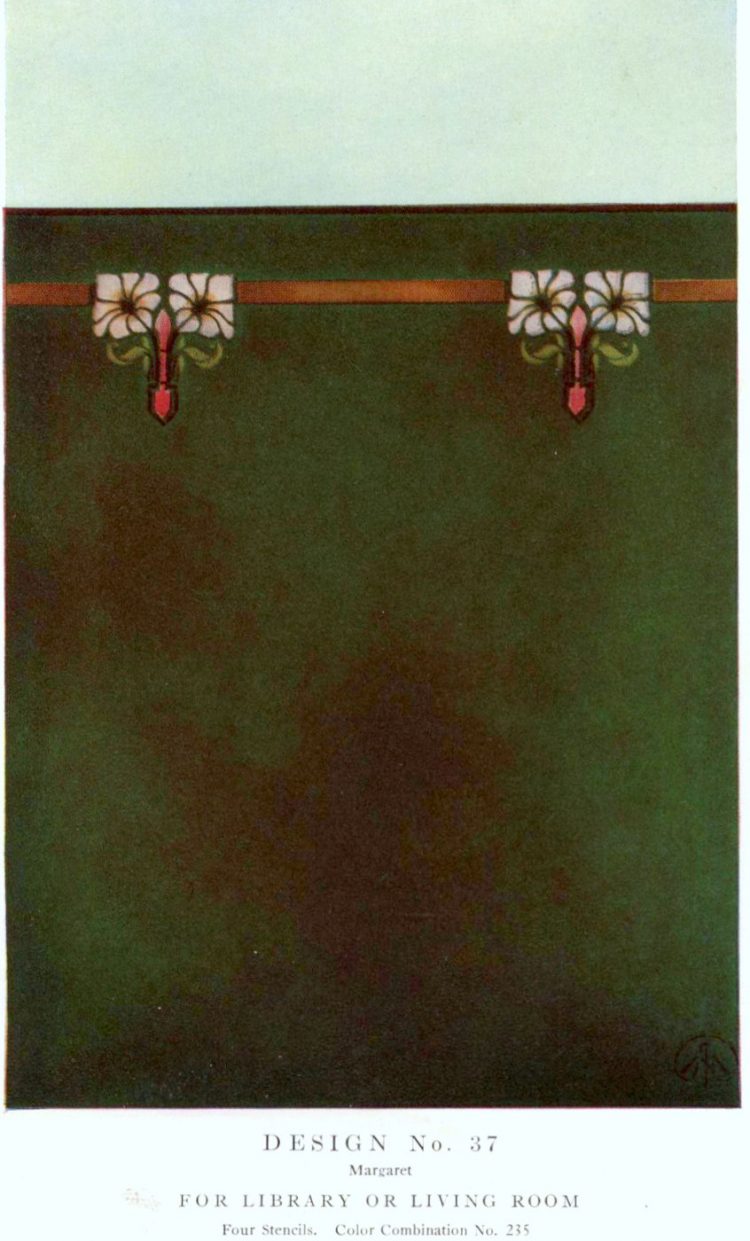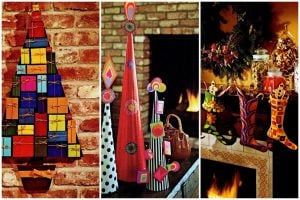Traditional stencil patterns: Try these timeless designs!
Whether you prefer florals, geometric shapes, or something else entirely, stencils offer endless possibilities. Plus, with just a bit of paint and a steady hand, you can create a beautiful custom look that’s uniquely yours.
Stencil patterns date back centuries and have been used in homes for generations. In the 18th and 19th centuries, they were a popular way to decorate walls, often mimicking more expensive finishes like wallpaper or wood paneling.
By the 1970s, stenciling saw a resurgence as DIY home projects gained momentum. Traditional patterns were everywhere — from kitchen walls to bedroom dressers — and the appeal still holds today for those who love a bit of retro flair in their home.
Traditional stencil patterns for every room
One of the best things about traditional stencils is their versatility. These designs can be used in any room, and they work on just about any surface, from wood to fabric. With a variety of classic designs to choose from, stencils let you add a touch of history to your home decor, without feeling stuck in the past. They also offer an affordable and relatively simple way to upgrade your space without a huge investment.
Below we’ve reprinted an article from 1975 discussing the popularity this decor trend enjoyed at the time. We’ve also gathered some vintage stencil patterns from the 1910s, perfect for sparking a bit of nostalgia or even inspiring your next project. So, if you’re ready to bring a little traditional flair to your home, scroll on — you just might find your new favorite design!
Stencil it and save (1975)
If there’s a room in your home that needs an instant perk-up, try easy stencil decorating to work low-cost magic.
Here, designer Richard Neas has used colonial motifs and such modern time-savers as fast-drying acrylic paints to bring color and charm to walls, floors and unpainted wood pieces.
Start with the simplest pattern and apply it to just one item. When you’ve mastered the technique, you’re ready to tackle larger projects.


Doing things the old way: Reviving the art of stenciling
[Original] Editor’s Note: An antique buff, Sunday News Reporter Deborah Brandt examines the current revival of stenciling, an art that goes back to seventh century China. In America. stenciled floors and walls were popular in 18th century homes.
by Deborah Brandt – Sunday News (Lancaster, Pennsylvania) February 2, 1975
The early art of stenciling provided colonial American families an inexpensive way to capture “folksy” elegance on floors, walls and furniture. Its graceful beauty has transcended mechanized, mass-produced decoration, and its popularity is growing with the help of artists who once again pick up paintbrush and stencil.
One such artist, Kenneth Fortney of Marietta, began stenciling a year and a half ago in a small apartment on Market Street, Marietta, and now has fine examples of his art in homes from Lancaster to York.

Fortney now makes his home in Marietta’s Railroad House, and one by one the rooms in that historic building are coming alive with his flowing designs. “I really became interested in stenciling about five years ago, but the fact that I could actually do it didn’t hit me until several years later.”
His excitement about the unusual art is evident when Fortney describes the history of and methods used in stenciling.
Traditional stencil patterns
A particularly joyful find was an entire portfolio of authentic Victorian stencils, which Fortney has used as patterns for several projects. He explained the stencils are cut from an oiled stencil board which is cleaned after each use.
“The technique,” remarked Fortney, “involves a stipple effect. Rather than brushing the paint on, it’s applied in dabs so the paint doesn’t run behind the stencils. It really doesn’t take much paint at all,” he continued, “because designs work best when the paint is applied very sparingly.”
The bible of stenciling for Fortney is a publication by Janet Waring entitled “Early American Stencils On Walls And Furniture.” Using the book as a background, he sketched the early history of stenciling from the seventh century A.D.

Used by the Buddhist monks as a means of reproducing sacred texts and placing patterns on temple walls, the stencil found its way into China after 600 A.D. During the eighth century, stenciling made its way into Japan, and as relations between East and West were carefully cemented, the stencil became more and more widely used.
Fortney noted growing uses of the stencil during the development of Europe — playing cards in the early 15th century, and block print coloring in the 16th.
Early 18th-century French wood engravers and colorists of painted papers similar to wallpaper dominos were known as dominotiers. The most famous of these men, Jean Papillon, used the stencil to color his dominos.
Wallpaper was an expensive commodity in the American colonies, Fortney related, and in its place, stenciling became a widely practiced trade, especially in the New England area.

The earliest date found for wall stenciling in America is 1778 on a Marborough, Mass., example. Fortney explained most of the remaining examples of wall stenciling were executed in the first half of the 19th century by a wide range of artists — primitive to highly disciplined.
Ofttimes, the artist traveled from house to house and town to town, offering his talent in exchange for a small wage, board and lodging.
Fortney claims no outstanding skill is required to stencil… practice and persistence leads to the proper techniques. He emphasized the broad number of designs which may be used in traditional stenciling, for borders around windows, walls above fireplaces, all-over decoration.
The most popular borders, Fortney continued, were flowering stems, acorns, conventionalized leaves and roses. These competed with stylized, geometric figures in usage for the outlining of windows, mantels and doors.
SEE MORE: Classic vintage stencil designs you can download & use
Fortney’s repertoire of designs include swags, weeping willows, pineapples, vines and flowers. He generally employs the colors most used by the itinerant stencil artists when possible, with blacks, greens, reds, yellows and pinks predominating.
Background colors, for the most part, are limited to paler shades of yellow, red-ochre, blue, and rose along with the muted off-white of plaster. He has, however, stenciled on top of deeper shades with most interesting results.

The beauty of stenciling, Fortney contends, is the generous amount of air that flows through both intricate and simple designs. The all-over design is not at all heavy or encumbered. “It’s really a nice alternative to wallpaper,” Fortney continued, “and the solid color wall.”
His method of working involves six to eight hour sessions a day… “Stenciling is very tedious, and especially when I’m working on walls, my arms get tired quickly. When it’s a floor to be stenciled, I have to work with my legs stretched out in front of me, behind me, under me… it’s not very comfortable after a while!”
Floors, Fortney related, may have been the first part of the house to be stenciled, since even the lowliest house could usually offer level floorboards when there was an absence of smoothly-plastered walls.
Rugs, he added, were much dearer than the quickly applied floor stencil, although the stenciled design called for constant replacement.
The patterns used for stenciling floors ranged from the simple, stylized unit to a more elaborate juxtaposition of design. Many times, the decorative placement of stenciling imitated the rich inlaid wooden floors used in more pretentious dwellings.
Stenciling, Fortney noted, was also employed in place of the canvas floor-cloths which were in vogue in colonial America, and provided an inexpensive alternative to warmly-colored Persian rugs.
Stenciling has become an appropriately popular art for today’s homes in light of the extensive restoration and refurbishing being tackled by local families. Artists like Kenneth Fortney provide the important link that bring yesterday’s charm in touch with today.
MORE: How to stencil a tray with an Early American design (1950)
Design inspiration: Antique traditional stencil patterns from 1914





Roman & Renaissance traditional stencil patterns from 1910

Egyptian and Persian traditional stencil patterns

Greek patterns for stenciling

Miscellaneous stencil patterns and decorative motifs


MORE: Vintage home wall decor from the 1910s, with 40 different room examples to inspire


Floral traditional stencil patterns




- Book of early American stencil designs
- 54 full sized patterns, ready to cut or copy
- Printed on heavy-weight stencil paper
- Tarbox, Charlene (Author)
- English (Publication Language)
- 80 Pages - 03/18/1994 (Publication Date) - Dover Publications (Publisher)
- Hardcover Book
- Marhoefer (Author)
- English (Publication Language)
- Jewett, Kenneth (Author)
- English (Publication Language)
- 128 Pages - 12/19/1979 (Publication Date) - Crown Pub (Publisher)
- Alice Bancroft Fjelstul (Author)
- English (Publication Language)
- 144 Pages - 04/29/1986 (Publication Date) - E.P. Dutton (Publisher)
- 100% Made in the USA since 2005 by our family-owned laser-engraving business.
- Uniquely artistic designs that always delight and uplift! We've coordinated designs within categories for creative collages and murals.
- Laser-cut on reusable 10 mil Mylar plastic -- safe and durable... perfect for stenciling flat or curved surfaces: walls, clothing, quilt squares, furniture, cakes, or crafts items!
- 100% Made in the USA since 2005 by our family-owned laser-engraving business.
- Uniquely artistic designs that always delight and uplift! We've coordinated designs within categories for creative collages and murals.
- Laser-cut on reusable 10 mil Mylar plastic -- safe and durable... perfect for stenciling flat or curved surfaces: walls, clothing, quilt squares, furniture, cakes, or crafts items!
- Package Includes:25pcs quilt pattern stencils for painting, each barn quilt stencil is 6x6inch.
- Sturdy&Flexible:Our quilt block stencils for painting are made of PET plastic material with good durability and flexibility.The thickness is 0.25mm,sturdier than others with 0.18mm.You can use the...
- Barn Quilt Stencil:Various quilt patterns to make different crafts including Martha Washington and Ohio Star.Customize your crafts with any color and combinations of patterns you like.
- ☆ COMPLETE SET OF LETTER STENCILS: There are 70 pack stencils in this stencil templates set, 26 uppercase letters, 26 lowercase letters, 10 numbers, and 8 most common signs. Complete set of letter...
- ☆ EASY TO USE: These stencils can save you a lot of time when creating crafts, you can customize words and numbers to create any art projects you want. You just put them on the surface of the...
- ☆ PREMIUM QUALITY: To ensure the flexibility and durability of the stencil, all stencil templates are made of premium quality mylar material, which are washable, reusable, tear resistant and not...
- Hardcover Book
- Brown, Ann Eckert (Author)
- English (Publication Language)





























